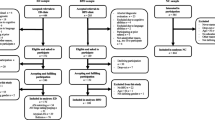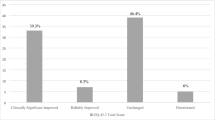Abstract
Objective. The Karolinska Psychodynamic Profile (KAPP) was used for the assessment of the six-month outcome of Brief Adlerian Psychodynamic Psychotherapy (B-APP). Method. Fifty-seven eating disordered women (28 with anorexia nervosa, 29 with bulimia nervosa), were included in the study. The sample was evaluated at baseline (time 0) and after six months (T6) with a clinical assessment and with Temperament and Character Inventory (TCI), Eating Disorder Inventory (EDI-2), State-Trait Anger Expression Inventory (STAXI), and KAPP. Results. Based on symptomatologic improvement, two sub-groups were obtained: responders (66.6%) and non-responders (33.3%). Significantly higher baseline scores emerged in the responders group on Ineffectiveness and Impulsivity (EDI-2) and on Harm Avoidance (TCI). Several KAPP items and areas improved in both groups at T6. Conclusion. Multimodal treatment centered on B-APP lead to both a global clinical improvement and an improvement in several psychological and psychopathological features as assessed by EDI-2, STAXI and KAPP. The results suggest interesting clinical implications, though outcome predictors are quite weak.
Similar content being viewed by others
References
American Psychiatric Association. Diagnostic and statistical manual of mental disorders. 4th ed., Washington DC, APA, 1994.
Halmi K.A., Eckert E., Marchi P., Apple R., Cohen J.: Comorbidity of psychiatric diagnoses in anorexia nervosa. Arch. Gen. Psychiatry, 48, 712–718, 1991.
De Groot J.M., Rodin G., Olmsted M.P.: Alexithimia, depression and treatment outcome in bulimia nervosa. Compr. Psychiatry, 36, 53–60, 1995.
Garfinkel P.E., Garner D.M.: Anorexia nervosa: a multidimensional perspective. New York, Brunner/Mazel, 1982.
Mitchell J.E., Peterson C.B., Myers T., Wonderlich S.: Combining pharmacotherapy and psychotherapy in the treatment of patients with eating disorders. Psychiatr. Clin. North Am., 24, 315–323, 2001.
Rovera G.G., Fassino S., Ferrero A., Gatti A.: Il modello di rete in psichiatria. Rassegna di Ipnosi, Minerva Medica, 74, 1–7, 1984.
Peterson C.B., Mitchell J.E.: Psychosocial and pharmacological treatment of eating disorders: a review of research findings. J. Clin. Psychol., 55, 685–697, 1999.
Robinson P.H.: Review article: recognition and treatment of eating disorders in primary and secondary care. Aliment. Pharmacol. Ther., 14, 367–377, 2000.
Dare C., Eisler I., Russel G., Treasure J., Dodge L.: Psychological therapies for adults with anorexia nervosa: randomised controlled trial of out-patient treatments. Br. J. Psychiatry, 178, 216–221, 2001.
Gabbard G.O., Atkinson S.D.: Disturbi del comportamento alimentare. In: Fassino S, Leombruni P. (Eds.), Trattamento dei disturbi psichiatrici. Torino, CSE, 2000, pp. 875–935.
Mc Intosh V.V., Bulik C.M., Mckenzie J.M., Luty S.E., Jordan J.: Interpersonal psychotherapy for anorexia nervosa. Int. J. Eat. Disord., 27, 125–139, 2000.
Gowers S.G., Norton K., Halek C., Crisp A.H.: Outcome of outpatient psychotherapy in a random allocation treatment study of anorexia nervosa. Int. J. Eat. Disord., 15, 165–177, 1994.
Herzog T., Hartmann A.: Psychoanalytically oriented treatment of anorexia nervosa. Methodology-related critical review of the literature using meta-analysis methods. Psychoter. Psychosom. Med. Psychol., 47, 299–315, 1997.
Steiger H., Israel M.A.: Psychodynamically informed, integrated psychotherapy for anorexia nervosa. J. Clin. Psychol., 55, 741–753, 1999.
Crisp A.H., Norton K., Gowers S.: A controlled study of the effect of therapies aimed at adolescent and family psychopathology in anorexia nervosa. Br. J. Psychiatry, 159, 325–333, 1991.
Eisler I., Dare C., Russel G.F., Szmukler G., Le Grange D., Dodge E.: Family and individual therapy in anorexia nervosa. A 5-year follow-up. Arch. Gen. Psychiatry, 54, 1025–1030, 1997.
Fairburn C.G.: Eating disorders. In: Science and Practice of Cognitive Behaviour Therapy. Oxford, Oxford University Press, pp. 209–241, 1997.
Garner D.M., Rockert W., Davis R., Garner M.W., Olmsted M.P., Eagle M.: Comparison of cognitive-behavioral and supportive-expressive therapy for bulimia nervosa. Am. J. Psychiatry, 150, 37–46, 1993.
Hay P.J., Bacaltchuk J.: Psychotherapy for bulimia nervosa and binging. Cochrane Database, 2001.
Agras W.S., Walsh T., Fairburn C.G., Wilson G.T., Kraemer H.C.: A multicenter comparison of cognitive-behavioral therapy and interpersonal psychotherapy for bulimia nervosa. Arch. Gen. Psychiatry, 57, 459–466, 2000.
Fairburn C.G., Norman P.A., Welch S.L.: A prospective study of outcome in bulimia nervosa and the long-term effects of three psychological treatments. Arch. Gen. Psychiatry, 52, 304–312, 1995.
Wilson G.T.: Treatment of bulimia nervosa: when CBT fails. Behav. Res. Ther., 34, 197–212, 1996.
Buckley P., Conte H.R., Plutchik R., Karasu T.B.: Psychodynamic variables as predictors of psychotherapy outcome. Am. J. Psychiatry, 141, 742–748, 1984.
Hoglend P.: Suitability for brief dynamic psychotherapy: psychodynamic variables as predictors of outcome. Acta Psychiatr. Scand., 88, 104–110, 1993.
Luborsky L., Crits-Cristoph P., Mintz J., Auerbach A.: Who will benefit from psychotherapy? Predicting therapeutic outcomes. New York, Basic Books, 1988.
Piper W.E., Hassan F.A., McCallum L., Joyce A.S.: Patient suitability and outcome in short-term individual psychotherapy. J. Consult. Clin. Psychol., 58, 1–7, 1990.
Svanborg P., Gustavsson J.P., Weinryb R.M.: What patient characteristics make therapists recommend psychodynamic psychotherapy or other treatment forms? Acta Psychiatr. Scand., 99, 87–94, 1999.
Endicott J., Spitzer R.L., Fleiss J.L., Cohen J.: The Global Assessment Scale, a procedure for measuring overall severity of psychiatric disturbance. Arch. Gen. Psychiatry, 33, 766–771, 1976.
Reich J.H., Green A.J.: Effect of personality disorders on outcome of treatment. J. Nerv. Ment. Disord., 179, 74–82, 1991.
Rossiter E.M., Agras W.S., Schneider J.A.: Cluster B personality disorder characteristic predict outcome in the treatment of bulimia nervosa. Int. J. Eat. Disord., 13, 349–357, 1993.
Sullivan P.F., Bulik C.M., Carter F.A., Joyce P.R.: Correlates of severity in bulimia nervosa. Int. J. Eat, Disord., 20, 239–251, 1996.
Bizeul C., Sadowsky N., Rigaud D.: The prognostic value of initial EDI scores in anorexia nervosa patients: a prospective follow-up study of 5–10 years. Eur. Psychiatry, 16, 232–238, 2001.
Kordy H., Percevic R., Martinovich Z.: Norms, normality, and clinical significant change: implications for the evaluation of treatment outcomes for eating disorders. Int. J. Eat. Disord., 30, 176–186, 2001.
Morgan H.G., Hayward A.E.: Clinical assessment of anorexia nervosa, The Morgan Russell Outcome Assessment Schedule. Br. J. Psychiatry, 152, 367–371, 1988.
Martin C.K., Williamson D.A., Thaw J.M.: Criterion validity of the Multiaxial Assessment of Eating Disorders Symptoms. Int. J. Eat. Disord., 28, 303–310, 2000.
Bulik C.M., Sullivan P.F., Joyce P.R., Carter F.A., McIntosh V.V.: Predictors of 1-year treatment outcome in bulimia nervosa. Compr. Psychiatry, 39, 206–214, 1998.
Fassino S., Abbate Daga G., Amianto F.: Outcome predictors in anorectic patients after 6 months of multimodal treatment. Psychother. Psychosom., 70, 201–208, 2001.
Hebebrand J., Himmelmann G.W., Herzog W.: Prediction of low body weight at long-term follow-up in acute anorexia nervosa by low body weight at referral. Am. J. Psychiatry, 154, 566–569, 1997.
American Psychiatric Association: Practice guideline for the treatment of patients with eating disorder (Revision). Am. J. Psychiatry, 157 (Suppl.), 1–39, 2000.
Brown J.M., Mehler P.S., Harris R.H.: Medical complications occurring in adolescents with anorexia nervosa. West J. Med., 172, 189–193, 2000.
Gowers S.G., Weetman J., Shore B.A., Hossain F., Elvins R.: Impact of hospitalisation on the outcome of adolescent anorexia nervosa. Br. J. Psychiatry, 176, 138–141, 2000.
North C., Gowers S., Byram V.: Family functioning and life events in the outcome of adolescent anorexia nervosa. Br. J. Psychiatry, 171, 545–549, 1997.
Gabbard G.O.: Psichiatria psicodinamica. Nuova Edizione basata sul DSM IV. Milano, Cortina Editore, 1994.
Siani R., Siciliani O.: Valutazione della psicoterapia mediante il “Karolinska Psychodynamic Profile (KAPP)”: Outcome a 2 anni su 60 pazienti psichiatrici. Quad. Ital. Psichiatria, 14, 293–374, 1995.
Turrina C., Siani R., Regini C., Campana A., Bologna R., Siciliani O.: Inter-observer and test-retest reliability of the Italian version of the Karolinska Psychodynamic Profile in two groups of psychiatric patients. Acta Psychiatr. Scand., 93, 282–287, 1996.
Weinryb R.M., Rössel R.J.: Karolinska Psychodynamic Profile — KAPP. Acta Psychiatr. Scand., 83(suppl 363), 1–23, 1991.
Weinryb R.M., Rössel R.J., Åsberg M.: The Karolinska Psychodynamic Profile. II. Interdisciplinary and cross-cultural reliability. Acta Psychiatr. Scand., 83, 73–76, 1991b.
Weinryb R.M., Gustavsson J.P., Liljeqvist L., Poppen B., Rössel R.J.: A prospective study of personality as a predictor of quality of life after pelvic pouch surgery. Am. J. Surg., 173, 83–87, 1997a.
Weinryb R.M., Busch M., Gustavsson J.P., Saxon L., Skarbrandt E.: Reliability of the Karolinska Psychodynamic Profile (KAPP) among patients with and without psychoactive substance abuse disorders. Psychother. Psychosom., 67, 10–16, 1998.
Weinryb R.M., Rössel R.J., Åsberg M.: The Karolinska Psychodynamic Profile. I. Validity and dimensionality. Acta Psychiatr. Scand., 83, 64–72, 1991.
Wilczek A., Weinryb R.M., Gustavsson J.P., Barber J.P., Åsberg M., Schubert J.: Symptoms and character traits in patients selected for long term psychodynamic psychotherapy. J. Psychother. Pract. Res., 7, 23–34, 1998.
Weinryb R.M., Rössel R.J., Gustavsson J.P., Åsberg M., Barber J.P.: The Karolinska Psychodynamic Profile (KAPP): studies of character and well-being. Psychoanal. Psychol., 14, 495–515, 1997.
First M.B., Spitzer R.L., Gibbon M., Williams J.B.: Structured Clinical Interview for DSM-IV Axis I Disorders. New York, Biometric Research, New York State Psychiatric Institute, 1995.
Cloninger C.R., Przybeck T.R., Svrakic D.M., Wetzel R.D.: The Temperament and Character Inventory: a guide to its development and use. St. Louis, Center for Psychobiology of Personality, 1994.
Cloninger C.R., Przybeck T.R., Svrakic D.M.: A psychobiological model of temperament and character. Arch. Gen. Psychiatry, 50, 975–990, 1993.
Cloninger C.R.: A practical way to diagnosis personality disorder: a proposal. J. Person. Disord., 14, 99–108, 2000.
Garner D.M.: Eating Disorder inventory 2: professional manual. Odessa, Psychological Assessment Resources, 1991.
Spielberger C.D.: State-Trait Anger Expression Inventory: Professional Manual. Odessa, Psychological Assessment Resources, 1996.
Weinryb R.M., Gustavsson J.P., Asberg M., Rossel R.J.: Stability over time of character assessment using a psychodynamic instrument and personality inventories. Acta Psychiatr. Scand., 86, 178–184, 1992.
Turrina C., Fiorazzo A., Turano A., Cacciani P., Regini C., Sacchetti E.: Depressive disorders and personality variables in HIV positive and negative intravenous drug-users. J. Affect. Disord., 65, 45–53, 2001.
Rovera G.G., Balzola F., Fassino S., Munno D.: Esperienze cliniche in tema di anoressia e bulimia. Arch. Psychol. Neurol. Psichiatry, 2, 233–261, 1998.
SPSS Base 8.0: Application guide. Chicago, SPSS, 1998.
Rothman K.J.: Modern epidemiology. Boston, Little, Brown and Company,1986.
Grove W.M., Andreasen N.C.: Simultaneous tests of many hypotheses in exploratory research. J. Nerv. Ment. Dis., 170, 3–8, 1982.
Garfinkel P.E., Kennedy S.H., Kaplan A.S.: Views on classification and diagnosis of eating disorders. Can. J. Psychiatry, 40, 445–456, 1995.
Keel P.K., Mitchell J.E., Miller K.B., Davis T.L., Crow S.J.: Long-term outcome of bulimia nervosa. Arch. Gen. Psychiatry, 56, 63–69, 1999.
Strober M., Freeman R., Morrel W.: The long-term course of severe anorexia nervosa in adolescents: survival analysis of recovery, relapse, and outcome predictors over 10–15 years in a prospective study. Int. J. Eat. Disord., 22, 339–360, 1997.
Bachar E.: The contributions of self psychology to the treatment of anorexia and bulimia. Am. J. Psychoter., 52, 147–165, 1998.
Hartley D.E., Strupp H.H.: The therapeutic alliance: its relationship to outcome in brief psychotherapy. In: Masling J. (Ed.), Empirical studies of psychoanalytic theories. Vol.1. Hillside, Analytic Press, 1983.
Luborsky L., Mintz J., Auerbach A.: Predicting the outcome of psychotherapy: findings on the Penn Psychotherapy Project. Arch. Gen. Psychiatry, 37, 471–481, 1980.
Leclerc C., Lesage A.D., Ricard N., Lecomte T., Cyr M.: Assessment of a new rehabilitative coping skills module for persons with schizophrenia. Am. J. Orthopsychiatry, 70, 380–388, 2000.
Anderson D.A., Maloney K.C.: The efficacy of cognitive-behavioral therapy on the core symptoms of bulimia nervosa. Clin. Psychol. Rev., 21, 971–988, 2001.
Gual P., Perez-Gaspar M., Martinez-Gonzales M.A., Lahortiga F., De Irala-Estevez J., Cervera-Enguix S.: Self-esteem, personality, and eating disorders: baseline assessment of a prospective population-based cohort. Int. J. Eat. Disord., 31, 261–273, 2002.
Jarry J.L.: The meaning of body image for women with eating disorders. Can. J. Psychiatry, 43, 367–374, 1998.
De Groot J., Rodin G.: Coming alive: the psychotherapeutic treatment of patients with eating disorders. Can. J. Psychiatry, 43, 359–366, 1998.
Author information
Authors and Affiliations
Corresponding author
Rights and permissions
About this article
Cite this article
Fassino, S., Daga, G.A., Delsedime, N. et al. Baseline personality characteristics of responders to 6-month psychotherapy in eating disorders: Preliminary data. Eat Weight Disord 10, 40–50 (2005). https://doi.org/10.1007/BF03353418
Received:
Revised:
Published:
Issue Date:
DOI: https://doi.org/10.1007/BF03353418




